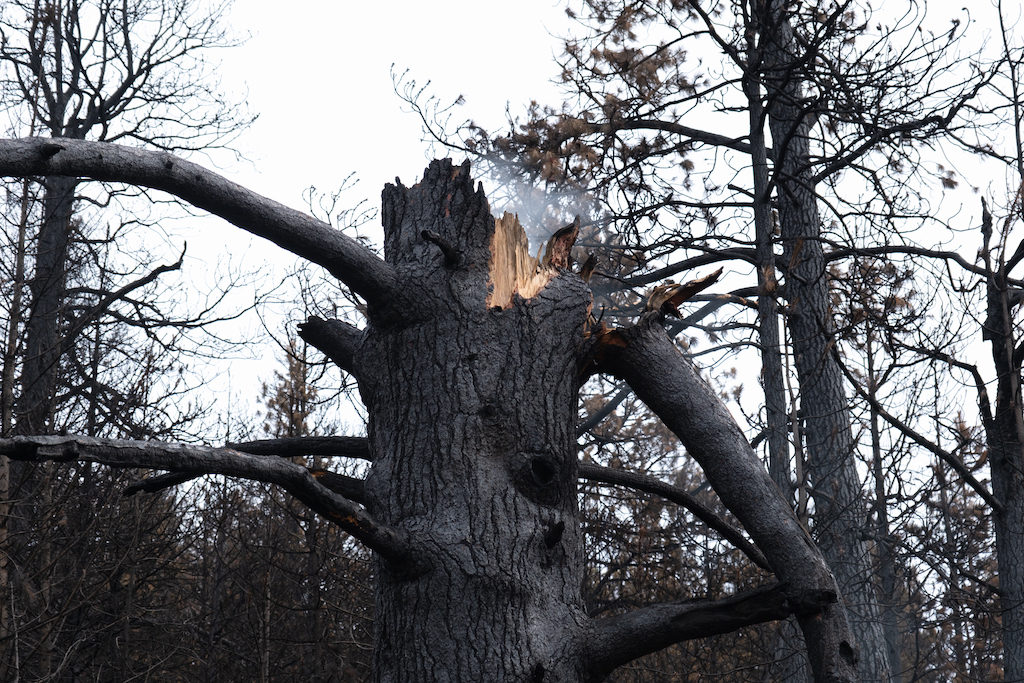Commentary: Oregonians deserve a smarter approach to wildfires
Published 6:31 am Wednesday, June 18, 2025

- A snag continues to smoke nearly two months after the Durkee Fire in eastern Oregon. (Erika Bolstad/Stateline)
Both suppression and risk reduction are necessary
Each year, Oregon braces for wildfire season. And each year, we spend tens of millions (sometimes hundreds of millions) trying to put those fires out. But despite our best efforts, the fires keep getting worse — more dangerous and more destructive.

Derek Johnson is the State Director of The Nature Conservancy in Oregon. For more than 20 years, Derek has worked for TNC in Wisconsin and Oregon and has served in multiple roles, most recently as the Oregon deputy director of operations and stewardship.
Science tells us that suppression alone isn’t enough. To meaningfully reduce risk, we must invest in proactive mitigation, restoring the health and resilience of fire-prone landscapes, and helping communities prepare for wildfire and smoke.
Trending
This legislative session, Oregon lawmakers have a chance to make an important initial investment to protect our forests, our homes, and our public health in the long run.
A package of bills now under consideration would provide $280 million per biennium for a comprehensive wildfire response. These bills reflect recommendations from the Wildfire Funding Work Group, convened by the State Fire Marshal, Oregon Department of Forestry, Governor Tina Kotek, Tribal Nations, and shaped by a wide array of stakeholders.
This legislation balances the ongoing need for firefighting with a long-term strategy, durable funding to reduce the risk of extreme wildfires before they start, and investments for communities and public health agencies to mitigate the impacts on people when wildfires do occur. That includes support for ecological thinning and prescribed fire — tools backed by science and proven to reduce the risk of severe wildfire in dry forest by up to 72% when used together.
The problem we face isn’t a mystery. More than a century of fire suppression left some of Oregon’s forests dangerously overgrown. In our dry forest regions, more than 6 million acres are now dense with small trees and brush — fuel for the next catastrophic fire. These ecosystems evolved with frequent, low- and moderate-intensity fires, such as from lightning and Indigenous fire use. Without fire, we’re left with unhealthy forests and increasing risk that the next lightning strike or unattended campfire becomes a megafire.

Lorelei Juntunen is the chair of The Nature Conservancy’s Board of Trustees and the president and CEO of ECONorthwest. She has devoted her career to improving policy outcomes at the intersection of public investment, equitable community and economic development, and housing affordability.
Landscape-scale forest restoration, when applied strategically to high-risk and high-priority areas, can reduce fire severity, protect nearby communities, and improve forest health. But it is a long-term strategy that requires sustained funding. Fortunately, it pays off: A recent benefit-cost analysis of landscape resilience and risk reduction treatments in the Western U.S. found that for every dollar invested, seven dollars of benefits are returned, a nearly 600% return on investment.
Meanwhile, suppression costs are soaring. Oregon’s gross suppression costs topped $350 million in 2024. The National Interagency Fire Center (NIFC) reports that annual federal wildfire suppression costs in the U.S. have exceeded $3 billion in recent years, with total economic damage (including property losses and recovery efforts) often surpassing $100 billion per year. Continuing to invest only in suppression is like mopping up water while the tap keeps running.
Trending
We must break the cycle. That means funding the firefighters and fire agencies that respond to wildfire and the foresters, prescribed fire professionals, scientists, public health experts and planners who work to make our forests and communities safer and healthier in the first place. Taken together, these investments are a meaningful step toward building more resilient, fire-adapted communities and landscapes in Oregon.
If we fail to act, we’ll be back here in a few years — only with more acres burned in extreme wildfire, more communities and landscapes at risk, and even higher costs.
Derek Johnson is the State Director of The Nature Conservancy in Oregon. For more than 20 years, Derek has worked for TNC in Wisconsin and Oregon and has served in multiple roles, most recently as the Oregon deputy director of operations and stewardship.
Lorelei Juntunen is the chair of The Nature Conservancy’s Board of Trustees and the president and CEO of ECONorthwest. She has devoted her career to improving policy outcomes at the intersection of public investment, equitable community and economic development, and housing affordability.







